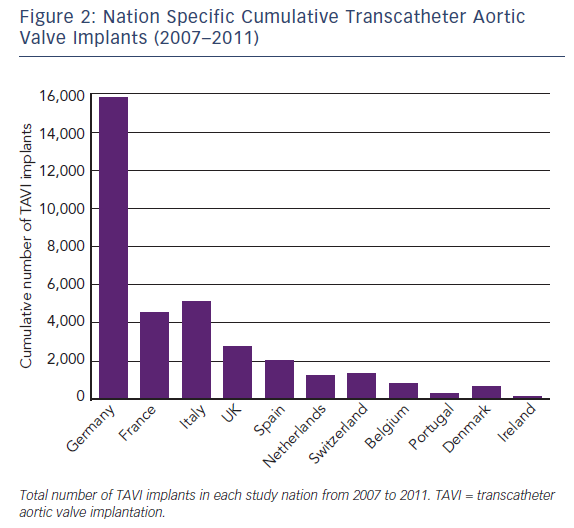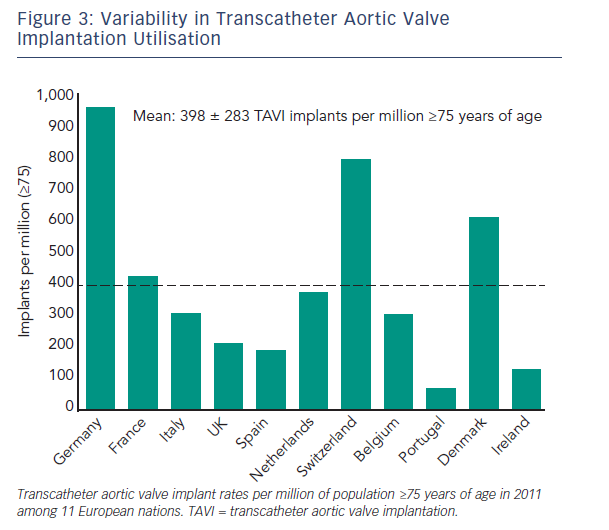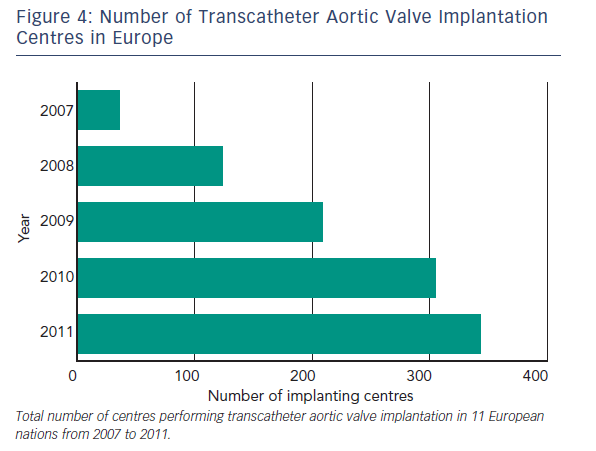Adoption of Transcatheter Aortic Valve Implantation
We evaluated TAVI adoption among 11 Western European  Nations-Germany, France, Italy, UK (including Northern Ireland), Spain, the Netherlands, Switzerland, Belgium, Portugal, Denmark and the Republic of Ireland.12 The number of TAVI implants and TAVI centres in each nation were retrieved from national databases that were submitted by a selected group of investigators. These data were
Nations-Germany, France, Italy, UK (including Northern Ireland), Spain, the Netherlands, Switzerland, Belgium, Portugal, Denmark and the Republic of Ireland.12 The number of TAVI implants and TAVI centres in each nation were retrieved from national databases that were submitted by a selected group of investigators. These data were  cross-referenced with TAVI use estimates derived by BIBA MedTech (London, UK), a cardiovascular market analysis group.
cross-referenced with TAVI use estimates derived by BIBA MedTech (London, UK), a cardiovascular market analysis group.
Between 2007 and 2011, 34,317 patients underwent TAVI in the 11 study nations. TAVI implants increased 33-fold from 445 in 2007 to 14,946 in 2011 (see Figure 1). Most implants were performed in Germany (45.9 %), Italy (14.9 %) and France (12.9 %) (see Figure 2). Portugal (0.6 %) and Ireland (0.4 %) accounted for the smallest proportion of implants.
 When the cumulative TAVI implant numbers were applied to year-end national population estimates, we observed considerable disparity in TAVI utilisation among nations (see Figure 3). In 2011, Germany (961), Switzerland (797) and Denmark (611) had the highest TAVI implant rates per million of population 75 years of age. Portugal (71) and Ireland (127) had the lowest TAVI implant rates.
When the cumulative TAVI implant numbers were applied to year-end national population estimates, we observed considerable disparity in TAVI utilisation among nations (see Figure 3). In 2011, Germany (961), Switzerland (797) and Denmark (611) had the highest TAVI implant rates per million of population 75 years of age. Portugal (71) and Ireland (127) had the lowest TAVI implant rates.
Transcatheter Aortic Valve Implantation Centres
The number of TAVI centres increased ninefold from 37 in 2007 to 342 in 2011 (see Figure 4). On average, there were 0.9 TAVI centres per million of population. In 2011, the number of  TAVI centres ranged from 0.3 per million in Portugal to 2.1 per million in Belgium. A high number of TAVI centres per million of population can result in fewer procedures being performed in each centre. Hence, guidelines recommend that TAVI procedures be centralised in high-volume regional centres to ensure adequate operator and centre experience.13,14 These volume-based recommendations suggest that a minimum of 24 TAVI procedures be performed in each centre per annum.13,14 Despite a European average of 41 TAVI implants per centre in 2011, Ireland, Belgium and Spain all had TAVI centres that performed <20 TAVI implants annually. The low number of implants per centre may be explained by the low procedural volume in Ireland and by a high number of TAVI centres in Belgium and Spain. National administration and funding agencies should be encouraged to centralise TAVI in designated TAVI centres and ensure that the recommended minimal implant volume is achieved.
TAVI centres ranged from 0.3 per million in Portugal to 2.1 per million in Belgium. A high number of TAVI centres per million of population can result in fewer procedures being performed in each centre. Hence, guidelines recommend that TAVI procedures be centralised in high-volume regional centres to ensure adequate operator and centre experience.13,14 These volume-based recommendations suggest that a minimum of 24 TAVI procedures be performed in each centre per annum.13,14 Despite a European average of 41 TAVI implants per centre in 2011, Ireland, Belgium and Spain all had TAVI centres that performed <20 TAVI implants annually. The low number of implants per centre may be explained by the low procedural volume in Ireland and by a high number of TAVI centres in Belgium and Spain. National administration and funding agencies should be encouraged to centralise TAVI in designated TAVI centres and ensure that the recommended minimal implant volume is achieved.